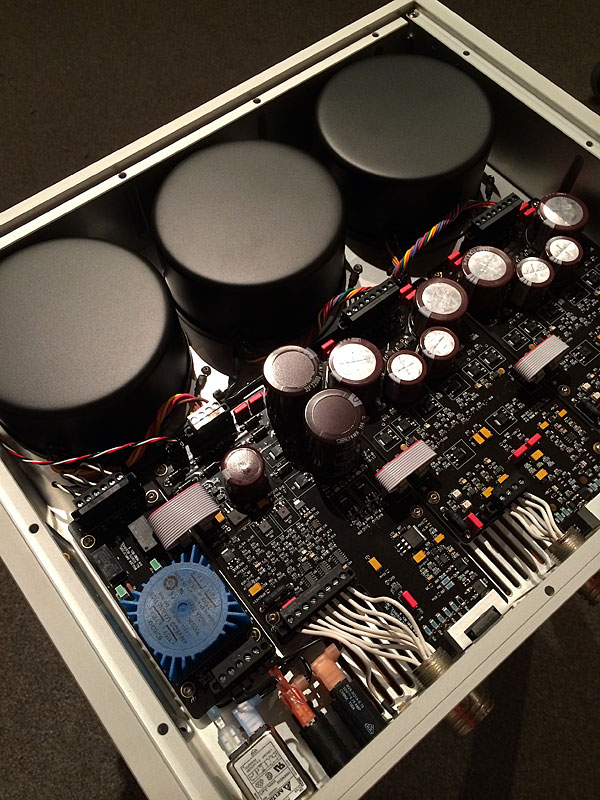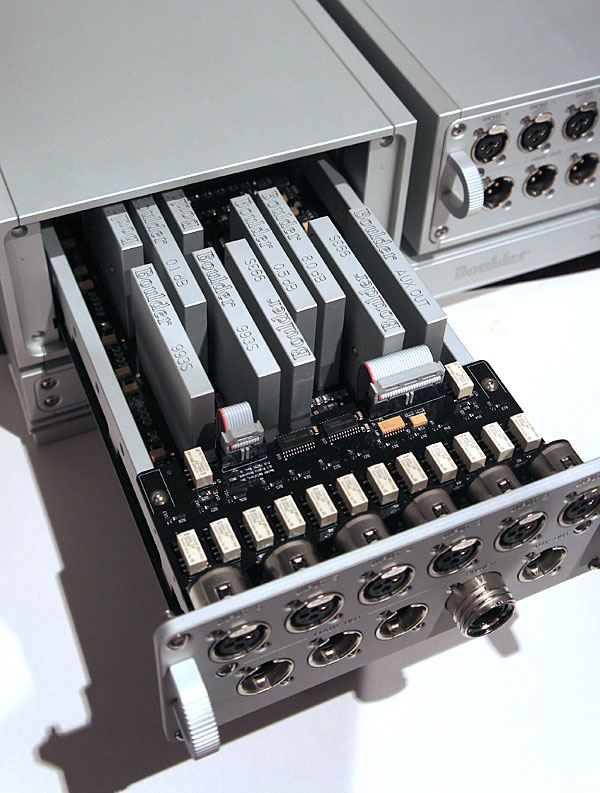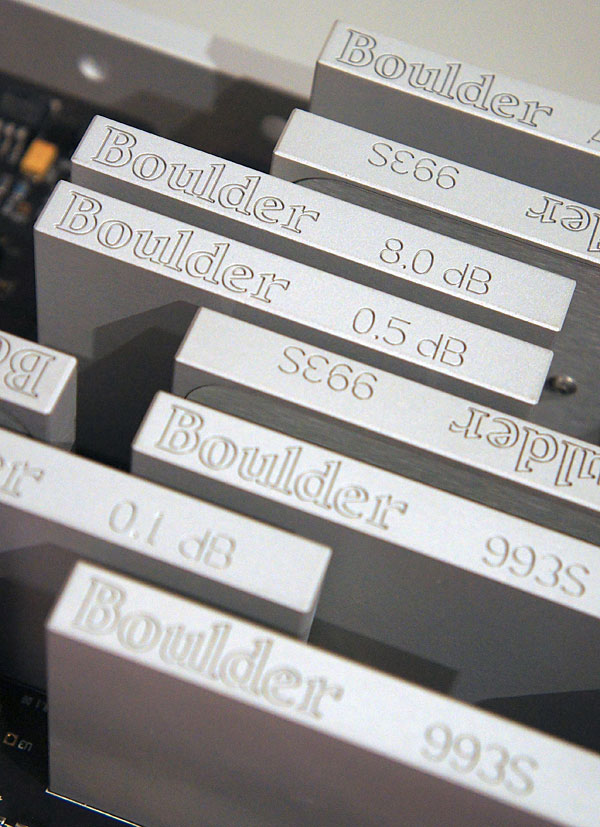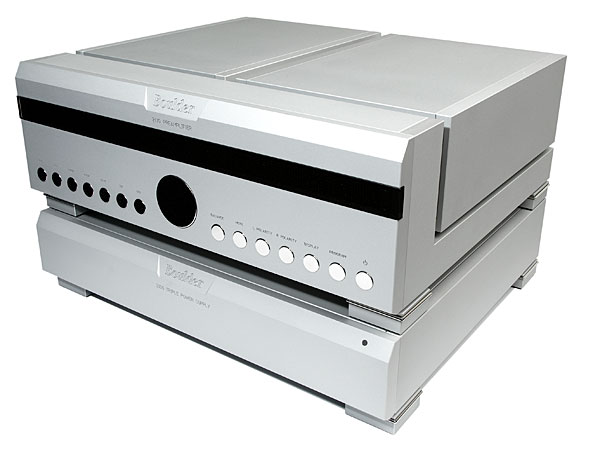| Columns Retired Columns & Blogs |
Hi Michael
I notice you are using both products as digital sources. Which do you prefer?
Scott
In today's zero-negative-feedback world, Boulder almost defiantly uses what it calls "correct and appropriate levels" of negative feedback to produce "ideal operating parameters" that include "gain determination, constant group delay across the entire bandwidth (maximally linear phase response) and bandwidth limiting." Boulder claims that negative feedback earned its bad reputation because, at one time, the op-amps used in wideband applications were too slow. However, Boulder claims that eliminating feedback produces sonic compromises and increased distortion.
Sound
I used with the Boulder 2110 a combination of single-ended and balanced source components, and ran the big darTZeel NHB-458 monoblocks in balanced mode via a long TARA Labs Zero balanced cable. (The darTZeels' actively balanced inputs use a translator to convert balanced signals to single-ended.) Hum, noise, hiss, and input-switch transients were nonexistent throughout the review period.

Immediately apparent on first listen was the 2110's grip on the music and, especially, on the illusion of space. Both my reference darTZeel NHB-18NS and the Dan D'Agostino Master Audio Systems Momentum preamplifiers throw large soundstages with billowy ease, but the Boulder produced image intensity, physicality, and solidity that were unprecedented in my experience. First take: a giant Wow.
Draw a line on a piece of paper. At one end write hard, etchy, overdamped, hyperfocused, and harmonically bleached. At the other end write soft, bulbous, cloudy, rhythmically flaccid, harmonically oversaturated, and dynamically restrained. You now have a visual representation of the extremes of the sonic continuum along which audio gear generally, and electronics in particular, can be placed. You could create other dichotomies: noisy–quiet, aggressive–limp, slow–fast, etc.—or, in the old days, solid-state–tube (though today's solid-state needn't sound transistory, nor tubes tubey).
The ultimate preamplifier is the proverbial "straight wire with gain"—as the 2014 December's cover indicates. It does nothing to the sound other than change its volume. Just as John Atkinson in that issue's review of the Ayre KX-R Twenty wishes he could have heard the Dan D'Agostino Momentum, the Lamm LL1 Signature, and the Simaudio Moon Evolution 850 preamps, I wish I could hear those and Ayre—but lately I've heard only the darTZeel NHB-18S (my reference), the Ypsilon PST-100 MK2, the D'Agostino Momentum—and the Boulder 2110. Though none of those models sounds like any of the others, all sit close to the center of that continuum, well away from either set of extremes. Where does the Boulder sit on the line, and relative to the other preamps I've heard? Well, that was the exercise.
The first recordings I had to hear through the Boulder 2110 were minimally miked spatial spectaculars. Equinox, by drummer Markus Schwartz and Lakou Brooklyn, is a remarkable, 24-bit/96kHz digital recording (WAV files, Soundkeeper SR1002). The ensemble consists of trumpet, hollow-bodied electric guitar, bass, and percussion performing lilting, simmering, hypnotic Haitian jazz. Equinox reproduces this ensemble with greater intimacy than do some other minimally miked recordings I can think of, yet the air is palpable. I play this file a lot.

Compared to my reference, the Boulder was placed toward the very center of the continuum, where images became better defined, the bass tightened, fingers pressing on guitar frets produced greater on/off delineation, and the overall aural picture snapped into greater focus. The sound was less relaxing and more exciting, with no downside.
That made me try a Norwegian album: Himmelskip (Ship of Heaven), by guitarist Iver Kleive and pipe organist Knut Reiersrud, recorded in a church to Studer analog (CD, Kirkelig Kulturverlsted FXCD163). It's like a two-man Pink Floyd album. The recording has space, deep bass, and a guitar that's easily lost in the ambience. The darTZeel reproduces it well, similar to how the D'Agostino did it, but the Boulder 2110's ability to grip the woofers and produce deep pipe-organ pulses as well as space-carving guitar transients brought Himmelskip into the greatest relief I've heard from it.

That led me to another recording made in a church: an unreleased 24/88.2k session by fellow Stereophile writer Bob Reina's jazz band, Attention Screen, engineered by John Atkinson and featuring Bob on church organ. The results were similar: the space reproduced by the 2110 was as generously wide and deep as through the slightly softer-sounding preamps, but bass definition was better, and in greater relief against the room backdrop. The chimes on this recording had greater crystalline clarity without sounding too etched.
A preamp, like the Boulder 2110, that specializes in carving space, 3D imaging, transient precision, and deep, tight, well-articulated bass can sound analytical and/or harmonically less than fully saturated. The Boulder suffered none of those maladies.
Chris Bellman's recent vinyl mastering of Joni Mitchell's Hejira (LP, Asylum/Rhino R1 01087) is much improved over the somewhat dynamically compressed original. Here, chorused electric guitar and Mitchell's closely miked voice could spell trouble for a fast, veil-lifting, well-detailed preamp, but the 2110's rendering of Hejira, and particularly its deft handling of transients, was mesmerizing. Its presentation of micro- and macrodynamics produced the good kind of chills. Not that the darTZeel didn't—but those chills just weren't as intense, or as ear-poppingly three-dimensional.
A test pressing of an upcoming reissue of Dean Martin's Dream with Dean (LP, Reprise/Analogue Productions) demonstrates what a superb singer he was. On this session, backed by a small combo, he's got his lips literally on the microphone. You can hear everything. Dean is in the room, but through a "no filter" preamp like the Boulder I also heard the mike's nonlinearity (or whatever caused the slight tonal astringency). The backing group, placed hard left/right and miked at a greater distance, sounded transparent and cleanly rendered but somewhat mellow, Dean slightly hard.
With the darTZeel back in place, two things happened: the combo's clarity softened and the transients lost some distinction, but Dean's voice sounded more natural, less hyper. Neither preamp gave me all I wanted from this superb recording.

I've been going through some used classical LPs I picked up at Quality Records in Melbourne, Australia, for $7 Australian, including a minty original pressing from 1972 of pianist Alicia De Larrocha performing Falla's Nights in the Gardens of Spain and Chopin's Piano Concerto 2, with Sergiu Comissiona and L'Orchestra de la Suisse Romande (UK Decca SXL 6528). As Deccas tend to be, it's a wonderful-sounding recording: a mid-hall perspective with a warm, full sound and natural instrumental focus through the Boulder. The piano sound in the Chopin, in particular, is as you'd hear it from at least 20 rows back, but despite the surrounding warmth, the piano's focus on the stage was cleanly rendered. When I returned the darTZeel to the system, this LP was equally satisfying, but with a slightly more relaxed sound and a bit more warmth, though the piano was equally well rendered and focused. Both presentations were "live"-like, but the Boulder, at almost twice the darTZeel's price—the NHB-18S currently costs 31,700 Swiss Francs, equivalent to $32,350—drew a more complete picture without sounding analytical. The D'Agostino Momentum would be closer to the darTZeel; the Ypsilon PST-100 MK2 in passive mode would be somewhat closer to the Boulder.
The Boulder 2110's dynamic slam, bottom-end grip, and overall focus made rock records and files pop from the speakers in 3D. The Grateful Dead's American Beauty (2 45rpm LPs, Warner Bros./Mobile Fidelity Sound Lab) and a test pressing of the Beach Boys' Surfer Girl (LP, Capitol/Analogue Productions) produced particularly holographic images, and a vivid tonality. The Boulder 2110 was as tonally neutral and transparent a preamp as I've heard. It was also drop-dead silent—free of such unwanted artifacts as grain, glare, and hyperdefined edge. I'm sure it will measure as well as it didn't sound.
Conclusions
When a preamplifier costs as much as a really nice car, its buyer is entitled to fanatical build quality in every aspect of its design, an enjoyable user interface, and faultless sound quality—as small a sonic fingerprint as is humanly possible, or none at all.
The Boulder 2110 delivered all of the above, and more. Its build quality and fit 'n' finish are top shelf, the user interface and remote control are glitch free, and it's easy and pleasant to use (though some might find the size of the characters on the LCD screen billboard-like) and the sound is as transparent and without character as I've heard from any electronics component.
The 2110 definitely did not sound, as Boulder detractors like to say, overly analytical, dry, or harmonically bleached. It made recordings I know to be truly exceptional sound even more so through my system. I could listen until as late at night as I could stay awake—and I did. The 2110 did nothing to hide the badness of truly awful recordings—or "unusual" ones such as Bruce Springsteen's The River—but it seemed to separate out the badness in such a way that my ears could more easily ignore it.
All of the preamplifiers mentioned in this review are exceptional components that I'd happily own and consider the job done. All sit close to one another on that continuum of sound quality and each presents a seamless, coherent sonic picture that gets out of the way and lets the recording shine through. But when the Boulder 2110 left the building, it took with it its holographic grip and spatial presentation, as well as its ability to resolve fine detail—qualities that raised my system to a level none of the rest could quite manage.

Hi Michael
I notice you are using both products as digital sources. Which do you prefer?
Scott